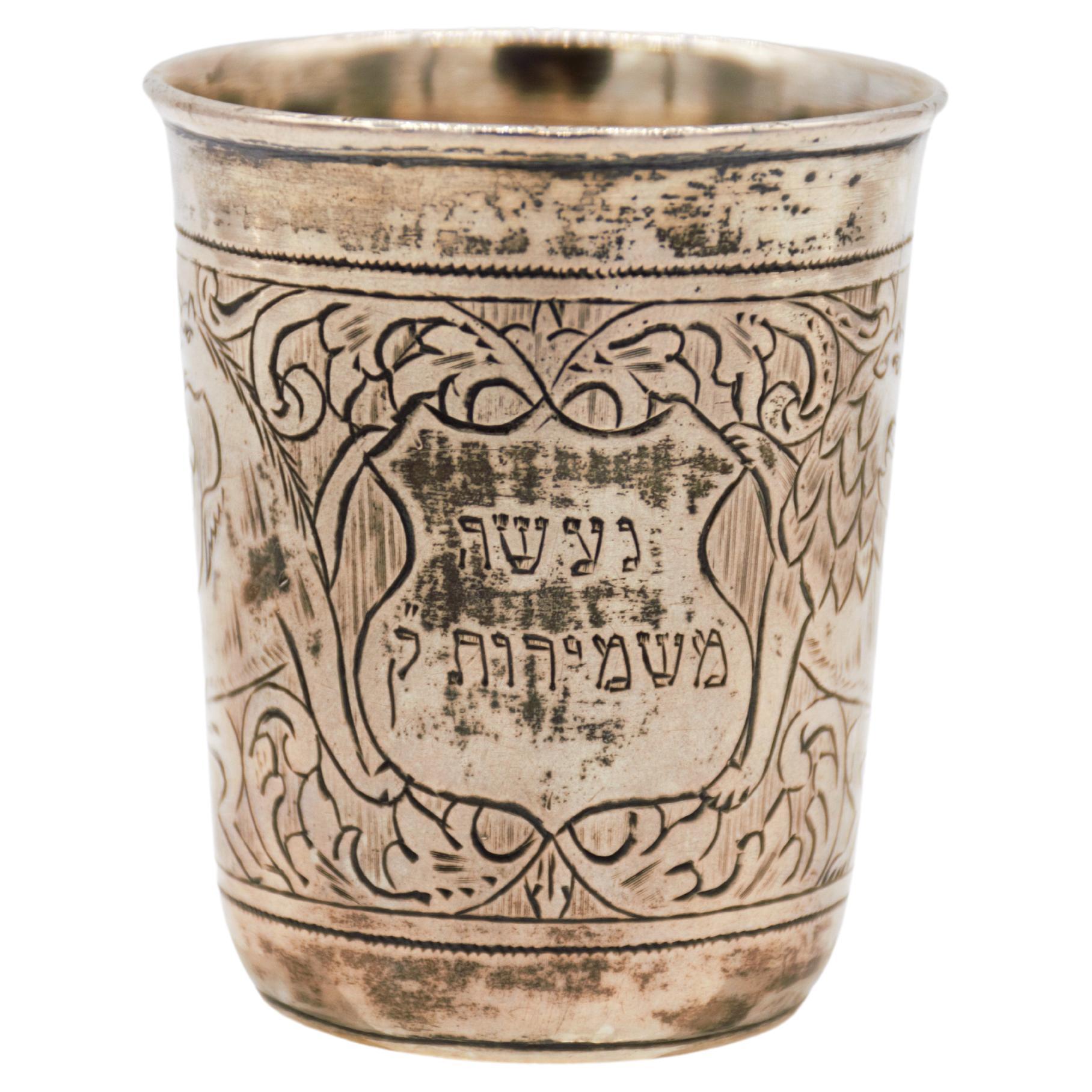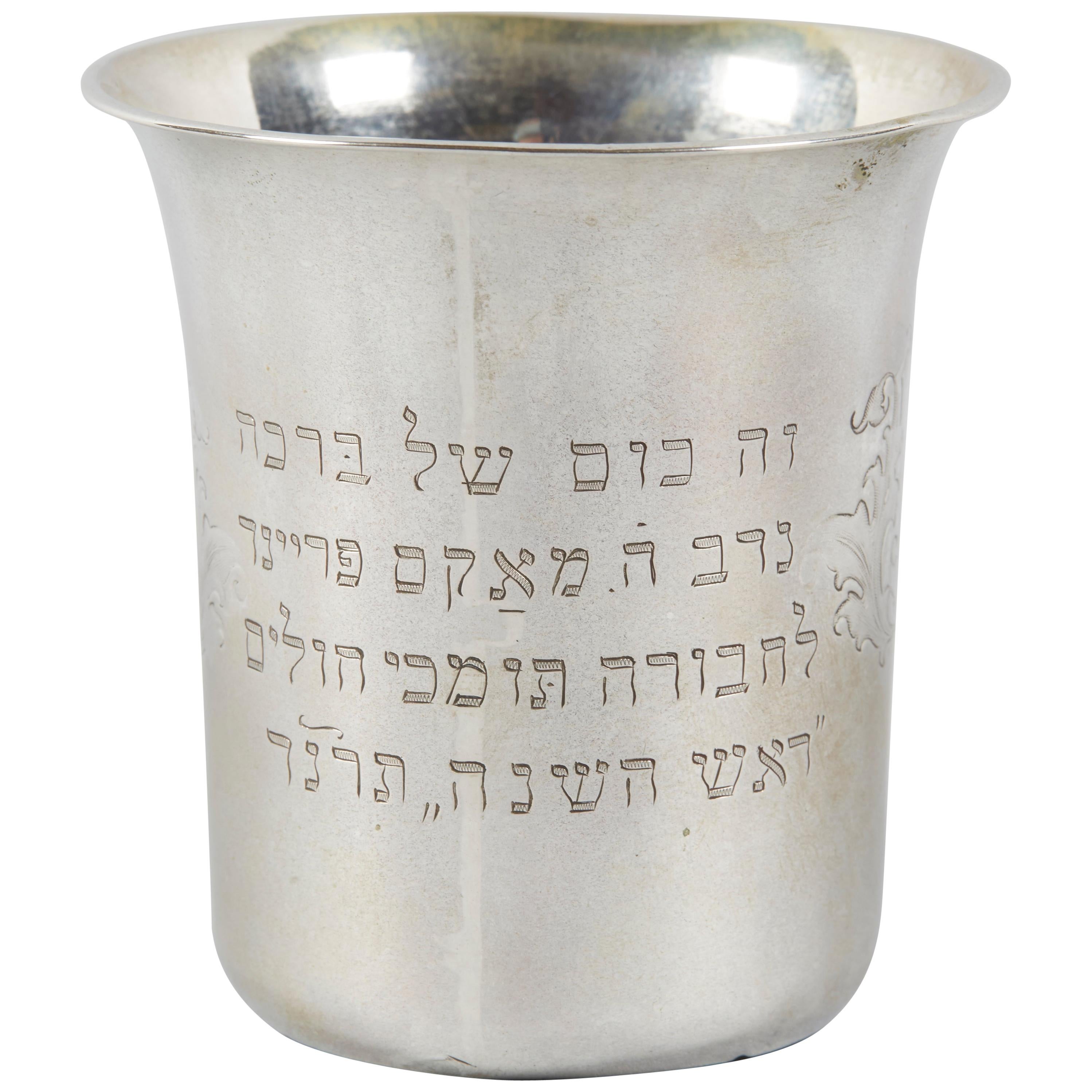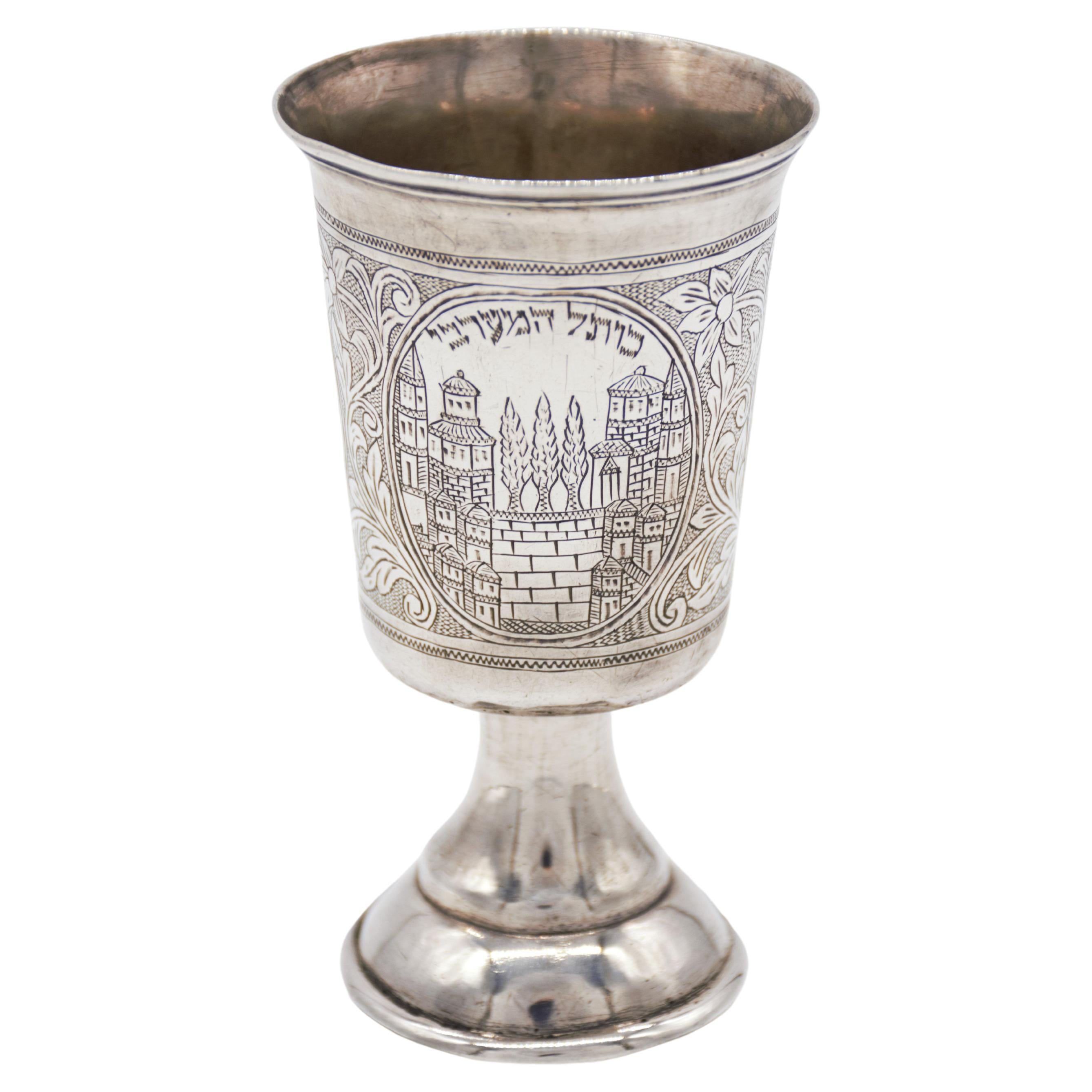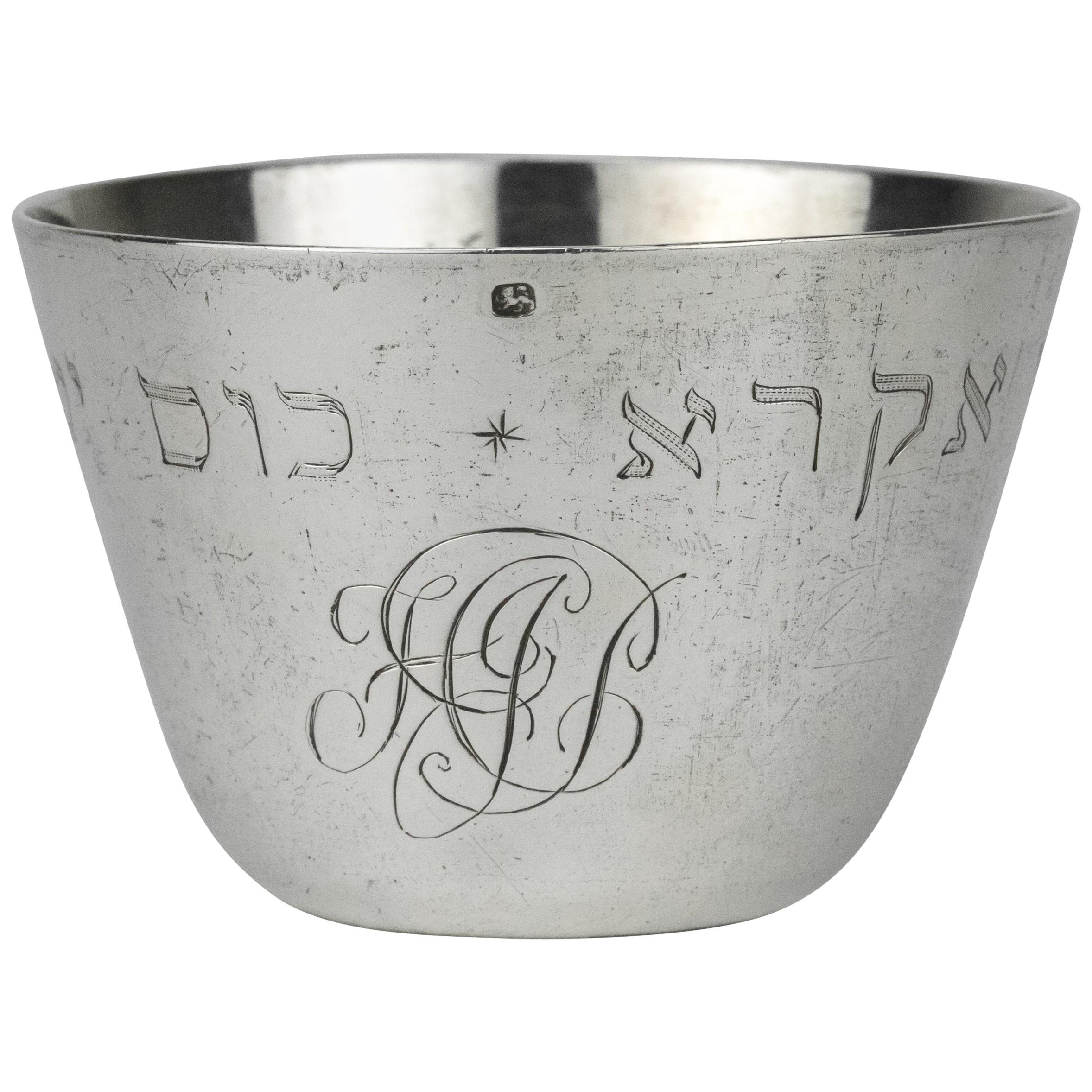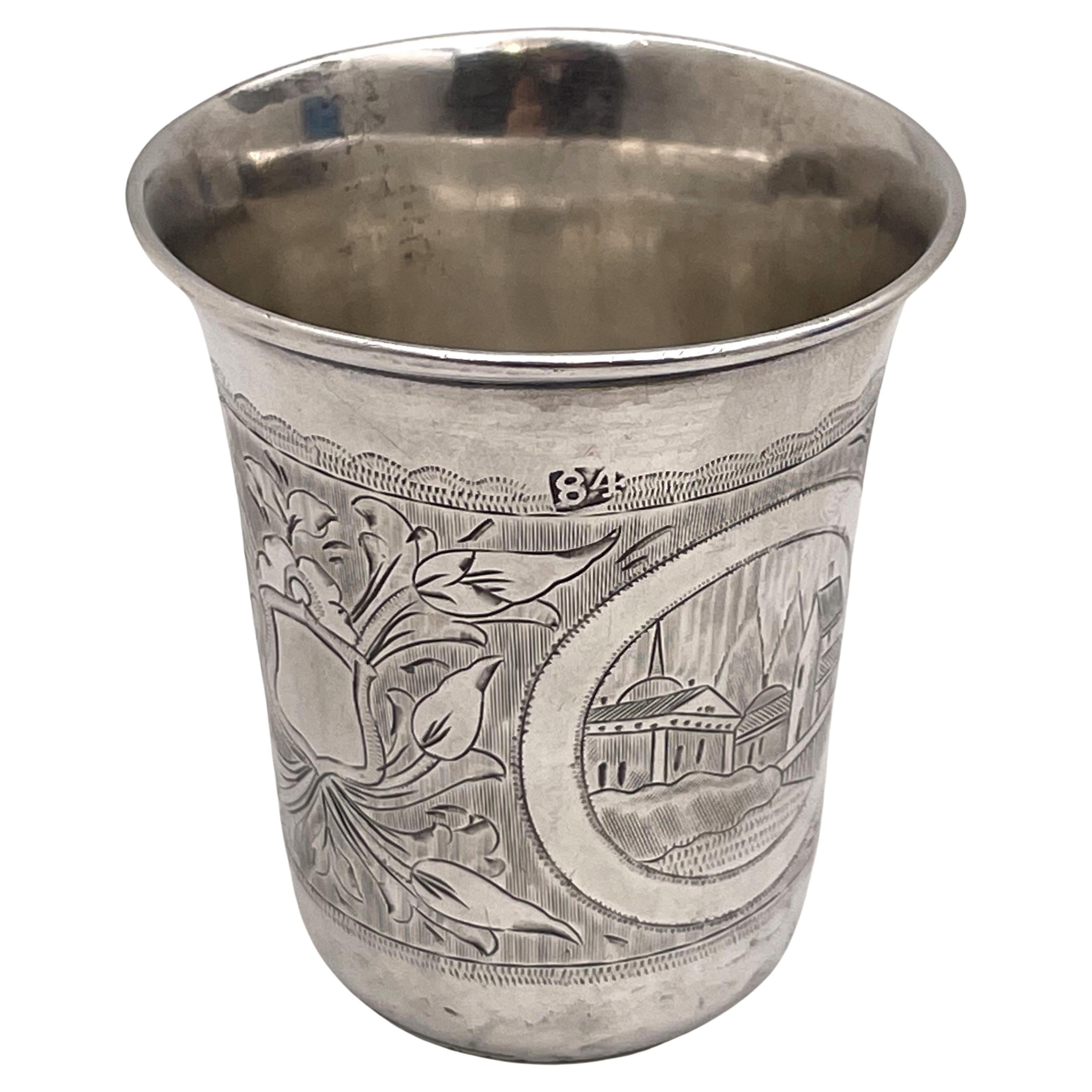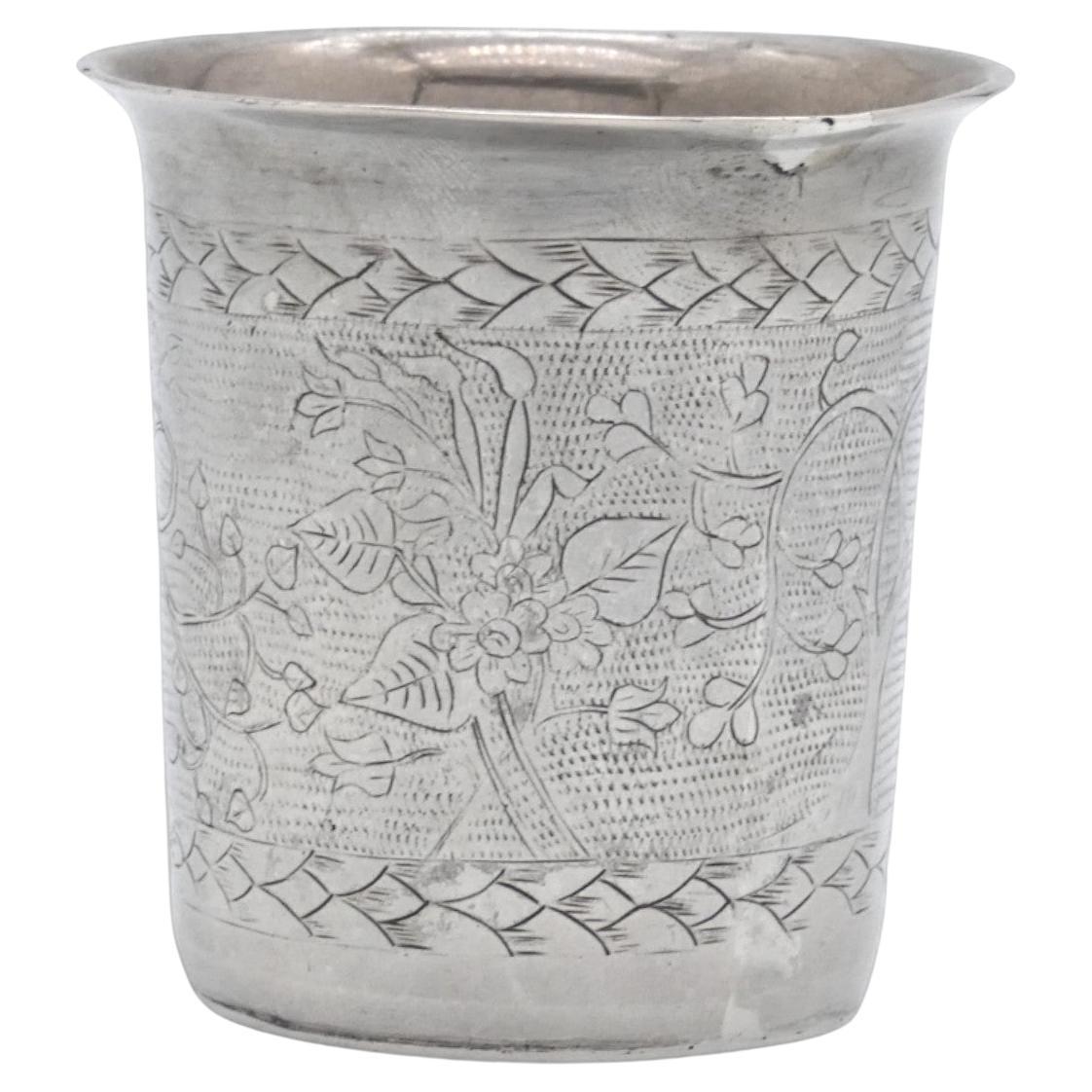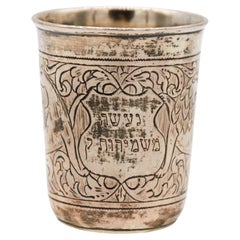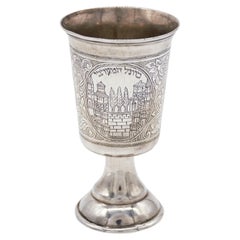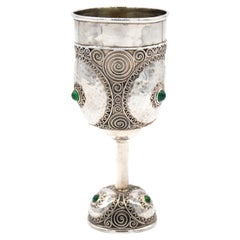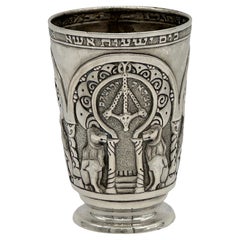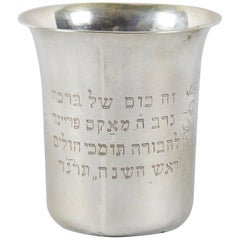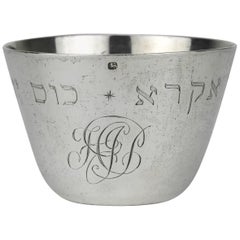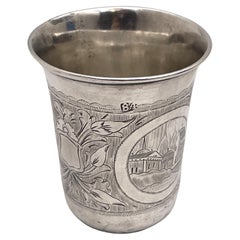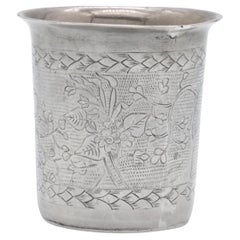Items Similar to Very Rare 18th Century Judaica Kiddush Cup, Rothschild Family Provenance
Want more images or videos?
Request additional images or videos from the seller
1 of 6
Very Rare 18th Century Judaica Kiddush Cup, Rothschild Family Provenance
$28,000
£21,245.76
€24,292.62
CA$39,108.41
A$43,483.23
CHF 22,704.54
MX$529,296.77
NOK 289,700.07
SEK 271,435.13
DKK 181,300.31
Shipping
Retrieving quote...The 1stDibs Promise:
Authenticity Guarantee,
Money-Back Guarantee,
24-Hour Cancellation
About the Item
This is a rare German silver kiddush cup that was made in Hochhausen (Tauberbischofsheim) or In the area, the marks on the cup relate to German silver in the 18th century, there Is a loth 13 silver mark which is 812,5 silver fineness.
A Jewish Community in Hochhausen has been known since the 17th century. In 1706, four Jews from Hochhausen were named, each of whom had to pay ten Guilders for protection money.
The Jewish Community in Hochhausen owned a synagogue, a Jewish school,
The Jewish cemetery in Hochhausen and a ritual bath, which adjoined the Property at Mühlenwörth 7. The bathing house that was probably there was about 3 m by 4 m and got the water of the Tauber via a small canal from the Mühlkanal. The ritual bath came into the possession of the mill around 1920 and was Probably filled in at the time. A separate religious education teacher was Employed, who also worked as prayer leader and schochet. In 1827 the Jewish Community in Hochhausen was assigned to the district rabbinate of Wertheim, Which temporarily had its seat in the Jewish Community of Tauberbischofsheim From 1850 to 1864.
The cup is adorned with an amazing engraving in old German style says :
Familie Rothschild
Hochhausen
We can see that the family member that ordered this cup from a silversmith was Proud in his family name as he asked it to be engraved in such bold germanic Style letters.
The font type is Fraktur it is a calligraphic hand of the Latin alphabet and any of Several blackletter typefaces derived from this hand. Letters are designed such That the individual strokes are broken apart; in this way it is often contrasted with The curves of the Antiqua (common) typefaces where the letters are designed to Flow and strokes connect together in a continuous fashion.
The first Fraktur typeface arose in the early 16th century, when Emperor Maximilian I commissioned the design of the Triumphal Arch woodcut by Albrecht Dürer and had a new typeface created specifically for this purpose, designed by Hieronymus Andreae.
The Rothschild family is a wealthy Ashkenazi Jewish family originally from Frankfurt that rose to prominence with Mayer Amschel Rothschild (1744–1812), a Court factor to the German Landgraves of Hesse-Kassel in the Free City of Frankfurt, Holy Roman Empire, who established his banking business in the 1760s. Unlike most previous court factors, Rothschild managed to bequeath his Wealth and established an international banking family through his five sons, who Established businesses in London, Paris, Frankfurt, Vienna, and Naples. The Family was elevated to noble rank in the Holy Roman Empire and the United Kingdom. The family's documented history starts in 16th century Frankfurt; its Name is derived from the family house, Rothschild, built by Isaak Elchanan Bacharach in Frankfurt in 1567.
During the 19th century, the Rothschild family possessed the largest private Fortune in the world, as well as in modern world history.[6][7][8] The family's Wealth declined over the 20th century, and was divided among many Descendants.[9] Today, their interests cover a diverse range of fields, including Financial services, real estate, mining, energy, agriculture, winemaking, and Nonprofits.[10][11] Many examples of the family's rural architecture exist across Northwestern Europe.
The first member of the family who was known to use the name "Rothschild" was Isaak Elchanan Rothschild, born in 1577. The name is derived from the German Zum rothen Schild (with the old Spelling "th"), meaning "at the red shield", in Reference to the house where the family lived for many Generations (in those Days, houses were designated not by numbers, but by signs displaying Different Symbols or colours). A red shield can still be seen at the centre of the Rothschild Coat of Arms. The family's ascent to international prominence began in 1744, with The birth of Mayer Amschel Rothschild in Frankfurt am Main, Germany. He was The son of Amschel Moses Rothschild (born circa 1710),
A money changer who had traded with the Prince of Hesse. Born in the "Judengasse", the ghetto of Frankfurt, Mayer developed a finance house and Spread his Empire by installing each of his five sons In the five main European Financial centres to conduct business. The Rothschild coat of arms contains A Clenched fist with five arrows symbolising the five dynasties established by the Five sons of Mayer Rothschild, in a reference to Psalm 127: "Like arrows in the Hands of a warrior, so are the children of One's youth." The family motto appears Below the shield: Concordia, Integritas, Industria (Unity, Integrity, Industry).
- Dimensions:Height: 3.4 in (8.64 cm)Width: 2.6 in (6.61 cm)Depth: 2.6 in (6.61 cm)
- Materials and Techniques:Silver,Hammered
- Place of Origin:
- Period:
- Date of Manufacture:1700
- Condition:Wear consistent with age and use. This kiddush cup is in a good condition, not restored and untouched, the inside is gold plated and so is the lip of the cup .
- Seller Location:Tel Aviv - Jaffa, IL
- Reference Number:1stDibs: LU8130233610462
About the Seller
No Reviews Yet
Vetted Professional Seller
Every seller passes strict standards for authenticity and reliability
1stDibs seller since 2023
- ShippingRetrieving quote...Shipping from: Tel Aviv - Jaffa, Israel
- Return Policy
Authenticity Guarantee
In the unlikely event there’s an issue with an item’s authenticity, contact us within 1 year for a full refund. DetailsMoney-Back Guarantee
If your item is not as described, is damaged in transit, or does not arrive, contact us within 7 days for a full refund. Details24-Hour Cancellation
You have a 24-hour grace period in which to reconsider your purchase, with no questions asked.Vetted Professional Sellers
Our world-class sellers must adhere to strict standards for service and quality, maintaining the integrity of our listings.Price-Match Guarantee
If you find that a seller listed the same item for a lower price elsewhere, we’ll match it.Trusted Global Delivery
Our best-in-class carrier network provides specialized shipping options worldwide, including custom delivery.More From This Seller
View AllA RARE SILVER SHMIROT KIDDUSH CUP. Galician, c. 1850.
Located in Tel Aviv - Jaffa, IL
A RARE SILVER SHMIROT KIDDUSH CUP. Galician, c. 1850.
Among some Hassidic courts, it was a practice for the Rabbi to give a blessed silver coin to his Hassidim as an amulet. Such protection might be given for all manner of life events, from healing from an illness to success in travel and the amulet was carried on the body of the recipient. This custom was particularly popular among the Ryzhiner Hassidim and these coins were called "Shmirot". To such coins were attributed extraordinary power and value and they were treasured with great care and love.
this cup is marked with polish loth 12 mark which indicate silver content of 75%.
Size :
Height 2.3 inch / 6 cm
Width : 2 inch / 5 cm
After the specific event for which they had originally be given, such a coin or coins were used in the making of other objects, which maintained the special aura of the Rabbi. Such a coin would be melted in other silver with the amuletic valued being spread evenly to all the silver. Then a ritual object would be fashioned by a silversmith and the special nature of the item would be inscribed on it, indicating in one of several ways that this object had been made from "Shmirot". this objects include Kiddish cups, a Havdalah tray, a Shabbat salt holder, a Chanukkah Menorah, a Torah crown etc.
This object is a Kiddish cup fashioned from such silver. On this cup, the inscription indicating Shmirot is found in the abbreviation of the words "made from shmirot k (kodesh)' " (This is the cup of Shmirot). Such cups were used for blessing the wine so that each use renewed the power of protection granted by the Rabbi. This cup was used for the blessing over wine on Shabbat and holidays. Inscription:
the other iconography on the cup is of a lion that represent Through the tribe of Judah, the lion symbol came to represent the blessing, majesty, and even divine protection of the Jews. The lion symbol continued to be used even after the destruction of Jerusalem, the capital of Judah's nation,
and a unicorn or a re'em, also reëm (Hebrew: רְאֵם), is an animal mentioned nine times in the Hebrew Bible It has been translated as "unicorn" in the Latin Vulgate, King James Version, and in some Christian Bible translations as "oryx" (which was accepted as the referent in Modern Hebrew),[citation needed] "wild ox", "wild bull", "buffalo" or "rhinoceros". Rabbi Natan Slifkin has argued that the re'em was an aurochs, as has Isaac Asimov...
Category
Antique 1850s Sterling Silver
Materials
Silver
Rare "Safed" kiddush cup, late 19th century Poland/ Eretz ISRAEL
Located in Tel Aviv - Jaffa, IL
This 84 silver cup was made in Europe, in Poland or parts of Poland that are in modern Russia in the 19th century, the interesting and important in this cup types is that they were s...
Category
Antique 1890s Israeli Sterling Silver
Materials
Silver
Important Early 20th Century Silver Kiddush Goblet by Bezalel School Jerusalem
Located in Tel Aviv - Jaffa, IL
Important Handmade sterling silver Kiddush goblet by Bezalel School, Jerusalem, circa 1910-1913.
On round base decorated with silver filigree and Cabouchon shaped green agate applications.
The base fitted with Bezalel mark. The upper portion is all adorned with amazing filigree work, the base and the actual cup adorned with swirling filigree designs, in the middle there are 3 roundels, made in another technique of hammered silver, similar to the works that were produced in this time all over Europe, in the middle of each roundel there is a perfectly centered Cabouchon green agate.
This work is attributed to Yehia Yemini.
The goblet is marked on the base, with the earliest silver mark of the school that just say "Bezalel" in Hebrew.
Yehia Yemini :
Was one of the biggest and must famous Bezalel silver...
Category
Early 20th Century Israeli Jugendstil Sterling Silver
Materials
Silver
Important Early 20th Century Silver Kiddush cup by Bezalel School Jerusalem
Located in Tel Aviv - Jaffa, IL
Important Handmade sterling silver Kiddush goblet by Bezalel School, Jerusalem, Circa 1910-1913.
On the cup there are 3 identical scenes of flanked lions and on the middle of them There are two columns with a staircase, this design is probably taken from Eastern European torah ark, on the middle part there is a chandelier with 3 tiger/lioness Heads, the top of the cup has 3 inscription on top of each flanking lions scene, first One says : ״כוס ישועות אשא״ (Psalms 116:13) which means " I will take the cup of Salvation", this is a rather common blessing on kiddush cups.
Next inscription says : ״אין שמחה אלא ביין״ in English " there is no joy except in wine" This says that after the temple was destroyed we have our joy only in the wine of Kiddish.
The last inscription says ״ושמחת בחגך״ (Deuteronomy 16:14 ) in English : "And you shall rejoice in your festival".
So this cup is a kiddish cup...
Category
Vintage 1910s Israeli Art Nouveau Sterling Silver
Materials
Silver
extremely rare Algerian Judaica silver, jewish Dowry box early 19th century
Located in Tel Aviv - Jaffa, IL
Amazing and scarce JUDAICA object, we have here one of the most touching jewish objects we had for a long time, this small silver dowry box was made in Algeria in the early 19th century, it is all covered with symbols of jewish faith and of couples, the sliding lid has 2 flanking birds with hamsa (protective hand) on each side and a flower vase in the middle.
one side shows two flanking lions with a tree in the middle and the other side shows again two big and two small birds with a flower bowl in the middle, front side has a key hole and next to it there is the Hebrew inscription ס״ט״" which says Siman tov or in English "a good sign" it is taken from the wedding blessing, underneath the lock there is another inscription with the name ״עזיזה בת אברהם בן חמו״ which is the name of the bride, her father and her grandfathers name.
the box is full marked a lot of times with the silversmith mark, every side of the box is marked.
this box was probably ordered by the grooms family to hold the jewelry they are giving to the bride as dowry, this type of objects are rare and there are just a few of them on museum collections.
DOWRY (Heb. נְדֻנְיָה), the property a wife brings to her husband at marriage; the Yiddish equivalent, nadn, is from the same root. The custom of nedunyah became clearly defined and institutionalized only in the talmudic period. In biblical times, mohar (מֹהַר), whereby the groom bought his wife from her father (Gen. 24:53; Ex. 22:15–16; Hos. 3:2), was the accepted practice. It was then customary that the groom give the bride gifts, and that she bring certain property to her husband's home upon marriage: slaves, cattle, real estate, etc. (cf. Gen. 24:59–61; 29; Judg. 1:14ff.; I Kings 9:16). Evidence of the custom of nedunyah is to be found in Tobit (7:14; 8:21) and in the Assuan papyri (Cowley, Aramaic, nos. 15, 18). Gradually, mohar was superseded by the ketubbah custom according to which the husband merely assumed the responsibility of compensation to his wife in case he divorced her: he had to pay her 200 zuzim if she had been a virgin at the time of marriage, and 100 zuzim if a widow or divorcée (see *Ketubbah).
By talmudic times, the institution of nedunyah was prevalent; the father gave a dowry to the bride since the daughter was excluded from paternal inheritance. Fifty zuzim (equivalent to the worth of 180 grams of silver) was the minimum amount a father was obliged to give to his daughter (Ket. 6:5). Parents usually gave much more, according to their social standing. Community funds provided the dowry for an orphan or a very poor girl (ibid.; cf. Sh. Ar., YD 251:8). In case of her father's death, the brothers of a minor girl were obliged to give her the minimum dowry, and the court estimated how much her father would have given her above the minimum dowry. The sum was then taken out of the father's estate and given to the daughter upon majority (Ket. 6:6; 68a–69b). In the absence of such an estimate, each daughter was entitled to receive one-tenth of the value of her father's estate in money, or in valuables (Yad, Ishut, 20:4–7; Sh. Ar., EH 113:4). If the father was unable or unwilling to pay the promised dowry at the betrothal ceremony, the groom could refuse to marry his bride (Ket. 13:5; Ket. 108b–109a). Insistence on exact payment of the promised dowry, however, was frowned upon by later rabbinic authorities (Rema to Sh. Ar., EH 2:1). In certain communities it was customary for the groom's father to make a dowry contribution equal to that of the bride's father (Ket. 102b). The dowry, whether given in real estate, slaves, money, or chattel was recorded in the marriage contract (the ketubbah) and in some instances one-third or one-fifth of the actual value of the dowry was added to the sum mentioned in the ketubbah. Based upon a decree enacted by *Simeon b. Shetah (first century C.E.), the Talmud ruled that the husband and his entire property were liable for compensation as stipulated in the ketubbah, either in case he died (when she collected the sum specified in the ketubbah from the heirs) or in case he divorced his wife (Ket. 82b). For the status of the dowry and the husband's rights and obligations, see below. The rabbinic enactments (Takkanot Shum) by R. Jacob *Tam and by the rabbinic synod of the communities of Speyer, Worms, and Mainz (Germany) stipulated that if a woman died...
Category
Antique Mid-19th Century Algerian Tribal Art
Materials
Silver
Rare German Parcel-Gilt Silver Canister, Abraham Drentwett i, Augsburg 1649-1666
Located in Tel Aviv - Jaffa, IL
Important German parcel-gilt silver canister, Abraham Drentwett I, Augsburg, circa 1649-1666 Abraham Drentwett I is one of Augsburg's foremost silversmiths during the Baroque period. He was Active 1641-1666 , he is best known for having executed Queen Christina's silver throne...
Category
Antique 17th Century German Baroque Sterling Silver
Materials
Silver
You May Also Like
Late 19th Century Continental Silver Kiddush Cup
Located in New York, NY
Hand engraved silver Kiddush cup, 1894.
Engraved with Hebrew text: "This cup of Blessing donated by Max Freined for "Aid for sick" society,
Rosh Ha'Shana, ...
Category
Antique 1890s European Religious Items
Materials
Silver
$1,248 Sale Price
26% Off
Mid-18th Century English Silver Kiddush Cup
Located in New York, NY
Engraved in Hebrew “I will raise the cup of deliverance, and I shall invoke the Name of G-d” (Psalms 116:13). To signify where the beginning and end of this verse is, an eight-pointe...
Category
Antique Mid-18th Century English Religious Items
Materials
Silver
$5,760 Sale Price
20% Off
Russian 0.84 Silver 19th Century Kiddush Cup
Located in New York, NY
Russian 0.84 silver Kiddush cup from the mid- to late 19th century (possibly 1869?) showcasing stylized natural and architectural motifs. It measures 2 1/3'' in height by 2 1/8'' in...
Category
Antique 19th Century Russian Barware
Materials
Silver
A Silver Kiddush Cup, Poland mid 19th Century
Located in New York, NY
A Tasteful Silver Kiddush Cup, made in Poland in the mid-19th Century.
The Kiddush beaker is set on a flat base and its main body has a cylindrical shape with a flaring lip.
Engrav...
Category
Antique Mid-19th Century Polish Sterling Silver
Materials
Silver
$1,200 Sale Price
20% Off
A Silver Kiddush Cup, Poland 19th Century
Located in New York, NY
A Nicely Engraved Silver Kiddush Cup made in Poland in the 19th Century.
Classic Polish kiddush cup that was commonly found in many households duri...
Category
Antique Late 19th Century Polish Sterling Silver
Materials
Silver
$1,120 Sale Price
20% Off
19th Century Polish Silver Kiddush Cup
Located in New York, NY
Engraved silver Kiddush cup, Poland, circa 1840.
On a flat base with floral decoration and with two village scenes engraving, one of the village scene depicting a tower with a simil...
Category
Antique Mid-19th Century Polish Religious Items
Materials
Silver
$1,500 Sale Price
20% Off
More Ways To Browse
Vienna 18th
11th Century Furniture
Antique Silver Payal
Silver Rose Water
Calligraphy Ceramics
17th Century German Engravings
Empire Cup
Engravings 1700
17th Century Cup
17th Century Cups
Sterling Watering Can
Sterling Silver Watering Can
Roman Cup
Maximilian Design
Sterling Kiddush Cups
Sterling Silver Kiddush Cup
Antique Kiddush Cup
Antique Kiddush Cups
